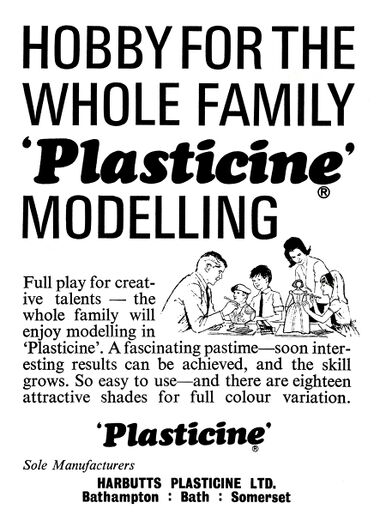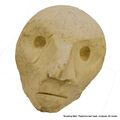Category:Plasticine: Difference between revisions
No edit summary |
m (-sp) |
||
| Line 21: | Line 21: | ||
==Variants== | ==Variants== | ||
* '''A.R.P. | * '''A.R.P. Plasticine''' – for gas-proofing rooms against poison gas attacks (~1939) | ||
* '''Fibrous Plasticine''' – with chopped-up wool fibres and antibacterial additives, Fibrous | * '''Fibrous Plasticine''' – with chopped-up wool fibres and antibacterial additives, Fibrous Plasticine was initially hoped to be a wonder material for medical dressings, it ended up being mostly useful for earplugs. | ||
* '''The | * '''The Plasticine Dartboard''' – (yes, really) | ||
{{Harbutt}} | {{Harbutt}} | ||
{{Clay}} | {{Clay}} | ||
{{WIP}} | {{WIP}} | ||
Revision as of 19:23, 19 February 2019
1932: "How to Model" series: "A Cow and Goat" [image info]
1967: Hobby for the whole family: "Plasticine modelling [image info]
The modelling material Plasticene was invented by William Harbutt (1844-1921), and was manufactured in Bathampton, Bath, England.
Original purpose
Unlike its American-origin competitor Play-Doh (which started out being marketed as a "cleaning putty" used to remove coal-dust marks from wallpaper), Plasticine was very much developed from the outset as a clean, stable modelling material, primarily for art students to practice on.
While clay was excellent for firing to make permanent sculptures, it was problematic as a teaching material due to its tendency to dry out: it might have to be prepared "fresh" in batches and carefully brought to the right consistency, students would come in for their weekly art lessons and start to make something, and after a few weeks, the surface properties for further working could already be deteriorating. Reusing clay meant adding water to replace what had evaporated and passing it through a "mincing machine" type apparatus until the added water was spread consistently through the mix.
Harbutt was artistically trained and had moved to Bath to teach art: consequently the understood the usefulness of an art material for "training" that was ready to use out-of-the box and didn't "age" or require valuable tutor time in preparation. Unlike clay, Plasticine was oil-based rather than water-based ... but it had sufficient additional ingredients not to appear too greasy.
While Harbutt's initial market for his invention (produced in batches in his basement) was art students, the new wonder modelling material eventually found a wider market in modelling shops and toyshops, and ended up being produced in a proper factory.
Formulation
Plasticine was initially about two thirds inert bulk or filler (initially fine wheat flour, later gypsum), with lanolin, stearic acid and petroleum jelly (e.g. "Vaseline"), mixed with lime (calcium oxide and/or hydroxide). The mixture would undergo a chemical reaction and get warm, and once it had settled down, it would be rolled to remove any water produced in the reaction, and then left to "mature" while exposed to the air for perhaps six months (which would probably give any remaining water the change to evaporate). The lanolin was later replaced by a different agricultural by-product, which supposedly worsened its previously "professional" modelling characteristics ... by not by enough for most people to notice, or to affect toyshop sales aimed at young children.
The "maturing time" was later reduced. For early "homebrew" batches, Harbutt eliminated water from the mixture by attacking it with a garden roller on his basement floor.
Colours
Initially produced in grey, Harbutt's artistic sensibilities allowed him to see the value of further R&D to produce Plasticine in a well-chosen range of really bright, vivid, eyecatching colours (which unfortunately didn't translate well to the black-and-white print advertising), and the Plasticine "Rainbow Packs" sold well.
Variants
- A.R.P. Plasticine – for gas-proofing rooms against poison gas attacks (~1939)
- Fibrous Plasticine – with chopped-up wool fibres and antibacterial additives, Fibrous Plasticine was initially hoped to be a wonder material for medical dressings, it ended up being mostly useful for earplugs.
- The Plasticine Dartboard – (yes, really)
Pages in category ‘Plasticine’
This category contains only the following page.
Media in category ‘Plasticine’
The following 29 files are in this category, out of 29 total.
- Are you a Model Mother, Plasticine advert (MM 1966-10).jpg 2,001 × 1,407; 781 KB
- Brilliant Box, Harbutts Plasticine (MM 1928-12).jpg 1,328 × 747; 628 KB
- Circus Animals Pack, Harbutts Plasticine (Hobbies 1966).jpg 1,596 × 1,497; 890 KB
- Hands Full of Pleasure, Plasticine (GaT 1956).jpg 1,847 × 3,000; 740 KB
- Handy One-Colour Pack, Harbutts Plasticine (MM 1964-12).jpg 2,225 × 1,505; 425 KB
- Harbutt's Plasticine (MM 1963-10).jpg 470 × 835; 82 KB
- Harbutt's Plasticine, Meccano (MM 1938-11).jpg 577 × 1,470; 227 KB
- Harbutts Plasticine (MM 1950-06).jpg 2,067 × 3,000; 1.78 MB
- Harbutts Plasticine Builder (Hobbies 1916).jpg 2,000 × 1,253; 913 KB
- Harbutts Plasticine for modellers and woodcarvers (HW 1913-07-06).jpg 1,800 × 760; 502 KB
- Harbutts Plasticine pack (MM 1963-10).jpg 467 × 247; 42 KB
- Harbutts Plasticine, British Industries Fair exhibition stand (GaT 1939-04).jpg 3,000 × 2,016; 2.98 MB
- Harbutts Plasticine, How to Model (MM 1932-04).jpg 709 × 955; 101 KB
- Harbutts Plasticine, logo (1913).jpg 1,550 × 1,150; 328 KB
- Harbutts Plasticine, logo (1914).jpg 1,750 × 650; 139 KB
- Harbutts Plasticine, logo (1939).jpg 1,800 × 432; 124 KB
- Harbutts Plasticine, range (GAT 1939-11).jpg 2,243 × 3,000; 1.08 MB
- Harbutts Plasticine, Roman City, Little Artist (GaT 1956).jpg 1,277 × 1,600; 312 KB
- How To Model, Cow and Goat, Harbutts Plasticine (MM 1932-04).jpg 1,040 × 729; 377 KB
- How To Model, Horse and Cat, Harbutts Plasticine (MM 1931-09).jpg 905 × 635; 337 KB
- James Mays Toy Stories, cover and spine (ISBN 9781844861071).jpg 1,451 × 1,600; 1.39 MB
- Plasticine (MM 1967-07).jpg 886 × 1,200; 412 KB
- Plasticine Builder, Harbutts Plasticine (Hobbies 1916).jpg 1,532 × 1,046; 895 KB
- Plasticine Dartboards, Harbutts (GaT 1939-04).jpg 3,000 × 1,983; 1.8 MB
- Plasticine Designer, box art (MM 1927-12).jpg 1,410 × 1,038; 845 KB
- Plasticine, One Pound Carton (Hobbies 1966).jpg 1,620 × 709; 396 KB
- Rainbow Box, Harbutts Plasticine, box artwork (MM 1927-11).jpg 1,350 × 1,345; 659 KB
- Scowling Man, Plasticine photogrammetry test (2019-04).jpg 880 × 879; 97 KB
- The Complete Modeller, Harbutts Plasticine (MM 1938-11).jpg 338 × 246; 45 KB






























